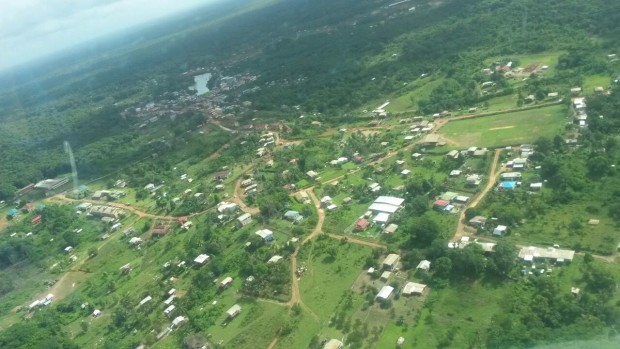

The Jonestown Massacre 36 years later
Archive 2014 Nov 27, 2014 Emily Singh


Port Kaituma Airstrip where Congressman Leo Ryan was shot and killed when visiting Jonestown in 1978 (PHOTO: Capt. Davendra. Singh)
The Jonestown tragedy in Guyana, South America was 36 years ago on Nov. 18, 1978. More than 900 people died in a mass suicide orchestrated by the leader of the Peoples Temple Jim Jones.
This grim day would be also remembered as when the most American lives were list in a non-natural disaster before the 9/11 attacks.
Gargeena Singh, who is now in her sixties and living in Winnipeg, Manitoba recalls what it was like hearing about the massacre during her life on the East Coast of Guyana in a village called Bladen Hall which is approximately 215 kilometers away from Jonestown.
“We were living in Bladen Hall at the time and we didn’t even know people were living out in that area it was all jungle area. We first heard about the killings over Radio Demerara, I was 30 at the time of the massacre and had never heard of something like that before, everyone was shocked,’’ says Gargeena Singh
Jim Jones was a man who could walk into a room and command attention. Through giving his followers at the Peoples Temple in San Francisco the promise of helping them and others in need he was able to attract them and manipulate their minds and put them through the ultimate test.
Jones had imagined creating what was known as a ‘Rainbow Family’ that included adopting children of various races.
Jim Jones led his followers from the Peoples Temple in San Francisco to a remote area of Guyana where he promised them paradise. Jones’s charismatic ways and people skills helped to attract loyal followers who looked up to him as a father figure. When they arrived in Guyana in 1974 they had no idea the hardship, suffering and death sentence they were about to face.
Space was limited and sleeping conditions consisted of crammed rooms and the agonizing sound of Jones’s voice over a 24/7 loudspeaker. Their days were rough and consisted of hard work in the hot sun, far from anything they could have imagined.
Jones’ mental state was deteriorating. Excessive drug use had begun to take its toll and paranoia and anxiety had set in. Jones believed American government officials and media outlets were out to expose him.
Communication between the members of the Peoples Temple in Jonestown and family members back in San Francisco, Calif. was limited and strained. Jones restricted letters coming in and out of the compound and would often script phone conversations between members and their families to avoid anything about their living conditions being revealed.
Four days before the mass suicide, Congressman Leo Ryan of California decided to pay Jonestown a visit after hearing rumours that Jones was running a cult out of Guyana. A NBC television crew accompanied Ryan to document what they would find. Upon seeing the condition of the compound and life that the followers were living, Ryan he offered to bring anyone who was unhappy back to California.
To avoid the truth getting out to the public about what Jones was doing at the compound, he arranged to have Ryan killed, Ryan was shot dead by a member of the Peoples Temple on the Port Kaituma Airstrip when boarding an Air Guyana Cessna aircraft.
“I’ve flown to the Port Kaituma Airstrip, where Congressman Leo Ryan was shot many times, and you can still to this day see the metal containers used during the massacre to mix the cyanide. It’s surreal to think about all the lives that were lost there everytime I fly to the Jonestown area,” says Capt. Davendra Singh, pilot at Air Services Limited in Guyana.
Prior to the mass suicide, there were ‘White Nights’ where Jones would announce over the infamous loudspeaker that outsiders from the U.S Intelligences services were attacking them. With his convincing charismatic ways he told his followers they needed to commit what would be known as the ‘Revolutionary Act’ of suicide through drinking flavour-aid laced with cyanide according to BBC News.
‘White Nights’ were practice drills to test the loyalty of his followers to verify that when he instructed them to consume the real drink of death. On Nov. 18, 909 people, including children, committed suicide by drinking cups of flavour aid mixed with cyanide. Babies had the lethal mixture injected into their mouths from the hands of their own mothers through syringes. According to BBC News, on that same day, Jones was found dead with a bullet wound to the head.
“It’s still important today because it is an example although extreme of where faith can lead especially what we called cults, this is not a phenomenon that has gotten away and its part of our larger look at the role of faith and whether that’s positive or negative. I think it’s still an instructive example even though it happened a long time ago,” says Andre Maintenay, religion in society professor at Humber College.








